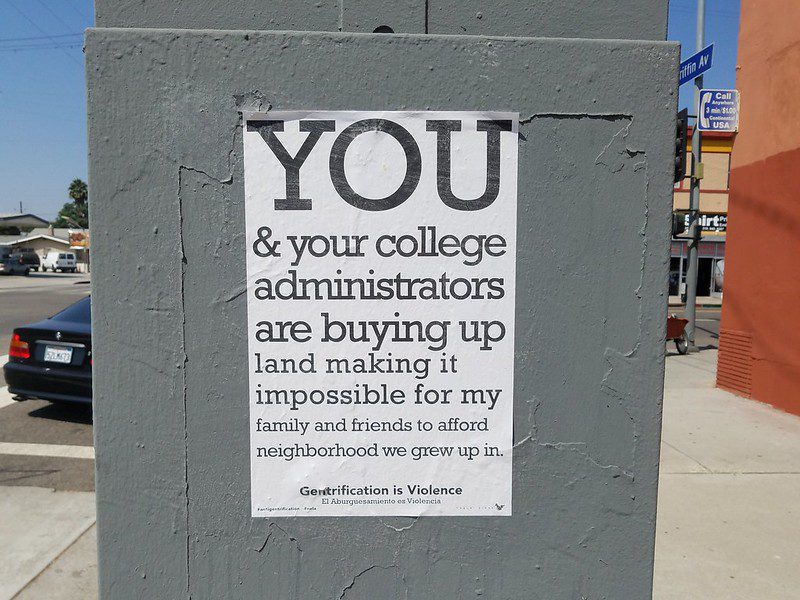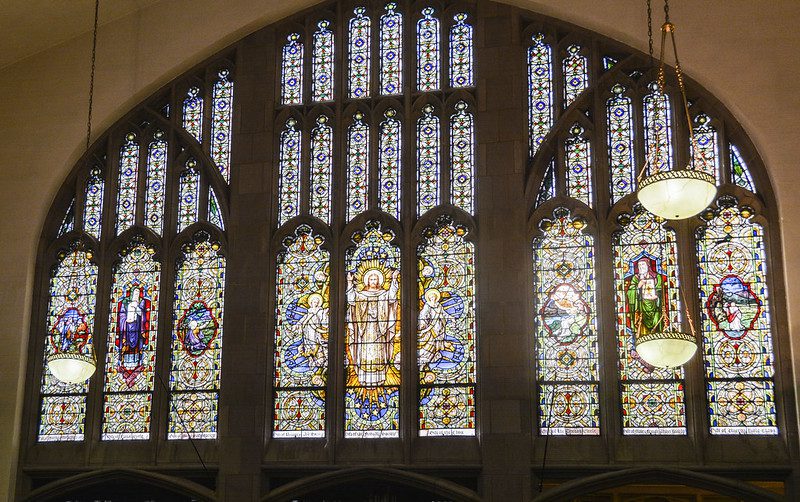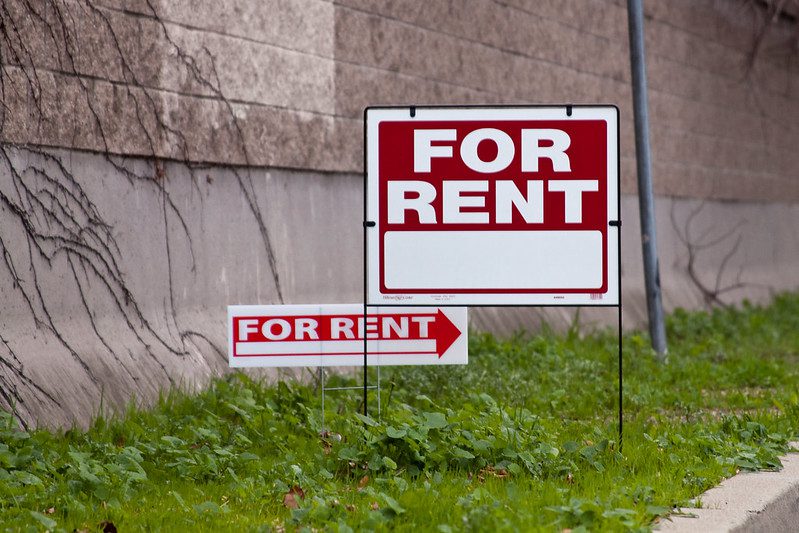
Photo by Flickr user Umberto Brayj, CC BY 2.0
Extracted. Dislocated. Enslaved. Confined. Dispossessed. Erased. Blamed. Policed. Criminalized. Disappeared.
These were the words that greeted me at a recent exhibit by artist, sociologist, and activist Shana M. griffin, whose work was on display at the Contemporary Arts Center in New Orleans last spring. The exhibit was called “DISPLACING Blackness: Cartographies of Violence, Extraction, and Disposability” and I was there to witness it with a local renters’ rights group. Together, we looked through the exhibit, which contained in-depth engagements with histories of Black dispossession and dislocation. And together we discussed current challenges to housing justice in New Orleans, from evictions to short-term rentals to, yes, gentrification.
A few weeks later, I opened my laptop to a Slack message: a collaborator had sent me a Shelterforce article called “‘Gentrification’ Is Not the Real Problem.” This collaborator and I were working on research related to redevelopment in New Orleans, and so engaging with this piece seemed important. To the author Brett McMillan’s immense credit, he has stirred up a thought-provoking conversation, at least amongst my comrades. But it was difficult for me to reconcile these two experiences: on one hand, an article that seeks to dismiss gentrification as a phenomenon we should care about, and on the other, the community organizers and others who care about it deeply. And so, as a scholar of housing and gentrification, I decided to pen an alternative point of view, framed largely as a response to the article. We must continue studying and fighting gentrification, rather than abandon the concept altogether.
McMillan argues that gentrification is not a problem because it’s based on “debunked theories” of displacement and racial change, and because it draws attention away from more “real” crises, like neighborhood inequality, affordable housing, and increasing cost burden. Both claims, I contend, are needlessly provocative, and rely on the selective disregard of certain evidence.
I’ll start with an obvious point: that a focus on gentrification is not antagonistic to a focus on other issues—in fact, gentrification is about housing affordability, cost burden, and inequality. As scholars like Neil Smith point out, gentrification is about capital flow, and how areas may be disinvested—and later re-invested—of resources at the whims of those who control capital, with immense implications for everybody else. When capital investment begins to creep back into some urban neighborhoods, others are left further neglected, and we end up with luxury condos instead of the decent affordable housing we need. New demand from new residents stresses the housing market, not just in gentrifying areas, but everywhere. Neighborhoods are not siloed, but rather are all parts of one city. Rising rents in one area surely don’t stay put—cost-burdened households move to progressively poorer neighborhoods, possibly stressing the housing markets there, too. Or they find ways to stay put, spending ever-increasing percentages of their income on rent.
[RELATED: What Does “Gentrification” Really Mean?]
An excellent way to illustrate the reaches of gentrification beyond any individual neighborhood is through the Housing Choice Voucher program, which provides rental subsidies based on a Fair Market Rent that is usually calculated using ZIP code or metropolitan area—in other words, encompassing at least several neighborhoods. Rising rents in the next neighborhood over, therefore, impact what affordable housing looks like in this neighborhood, too. The Low-Income Housing Tax Credit, linked to an area median income threshold, relies on a similar logic.
But don’t take my word for all of this—McMillan actually says it better. Imagine my surprise when, midway through the article talking about how gentrification isn’t a real problem, the author describes “a process that is far more insidious …” and proceeds to spend a paragraph describing gentrification near-perfectly. “Wealthier residents trickle back into a select group of desirable neighborhoods. . . . The attraction to these neighborhoods siphons away investment and interest from other parts of the city, concentrating resources. Thus, for people who happen to own homes outside gentrifying areas . . . their home equity often lags behind.” Yes. Exactly. This is part of gentrification too—not just the coffee shops and vintage boutiques.
Let’s also discuss evidence, and what exactly constitutes “reality,” a word that comes up several times in McMillan’s piece. To show that gentrification has been “debunked,” a few quantitative articles are presented, each of which appear to show that displacement, or a coerced housing move, is not more prevalent in gentrifying areas. But qualitative studies—ones that incorporate interviews or ethnography instead of numbers—tend to find the opposite. Articles and books drawn from the words of communities in Chicago, San Francisco, Washington, D.C., and many other places consistently affirm the deleterious effects of gentrification.
This tracks with the observations of Japonica Brown-Saracino, who writes about a “methodological divide” in gentrification studies between qualitative and quantitative scholars. Basically, whenever researchers go out and talk to people, many view gentrification as a problem in their city or neighborhood and speak of dislocation and erasure. But then when we look at the numbers, some studies find limited evidence of actual displacement. So what should our response be to these disparate findings? Should we draw a narrow view of ‘reality’, double down on the numbers, and tell these residents that they’re wrong? Or should we perhaps acknowledge that something is happening here, something that our quantitative measurements aren’t quite capturing, and therefore work to adjust the measurements?
I use the word “some” here because, actually, the quantitative literature is much more nuanced on the relationship between displacement and gentrification than to simply say, “No, it doesn’t exist.” For instance, Isaac William Martin and Kevin Beck, in a 2018 study, do not find evidence that homeowners in gentrifying areas are displaced—but do show that renters in gentrifying areas are. Indeed, Julie Mah utilizes six years of eviction records in Detroit to show how tenants are moved from a gentrifying downtown neighborhood to the city’s periphery. Elora Lee Raymond and colleagues look at investor purchases of multifamily rental housing in Atlanta, and find that they tend to predict a spike in eviction judgments and a loss of Black residents in the area. The numbers are there, if not simply ignored.
Jacob Carlson dives further into what we mean when we talk about measuring displacement—which, after all, is an extremely difficult thing to get accurate numbers on. He notes several different ways of doing so, all of which produce different findings and have different implications for gentrification studies. I add this just to point out that numbers are not monolithic, nor unbiased (even if they’re often painted as such, and can therefore be viewed as more “real”). There are numerous ways of measuring and presenting concepts like displacement and gentrification and building toward further specificity should be a goal of ours, not throwing out the concept entirely.
All of this isn’t even to mention that gentrification is so much more than housing displacement. Gentrification shows us that when places do change, rarely do their most vulnerable residents have much of a say in how that’ll go down. And so longtime residents lose to gentrification the institutions that cater to them. They may lose a sense of community, a sense of belonging. They are more heavily policed. Cultural shifts in favor of the whiter and wealthier may lead to conflicts over the schools that their children attend and norms surrounding public spaces. As essayist Hanif Abdurraqib so movingly writes in A Little Devil in America, “Much of our living is an act of painting over an existence before ours, and my understanding of that doesn’t dim the pain I feel at the new unfamiliarity of spaces I’ve been in.” While these concerns are perhaps not always our most pressing, given more immediate crises of shelter, they are vital to a full realization of community development.
[RELATED: What We Don’t Know About Development and Displacement]
This is also why it is a mistake to offhandedly dismiss the racialized components of gentrification, as McMillan does in the couple of paragraphs where he “tackle[s] race.” In the exceptional book Chocolate Cities, authors Marcus Anthony Hunter and Zandria F. Robinson write of how Black folk, inheritors of neglected and disinvested neighborhoods, used these spaces to create culture, power, and networks. Erasure and appropriation of these narratives and cultures result whenever white people place value in these places again. “Gentrification has also shifted and often devastated Black neighborhoods across urban America,” they write, an argument that is confirmed in other studies as well. I would also point out that perhaps it is not for white academics to decide what is and what isn’t the “problem” in communities of color. Perhaps we should listen carefully before making bold claims about a “reality” that we don’t experience.
Overall, there are plenty of ways in which the field of gentrification studies could improve. The concept does often suffer from a lack of definitional specificity. There is still much reckoning to be done with regard to race, the white appropriation of space, and the resistance of people of color. And of course, there is this “methodological divide” that could use some bridging. There is so much more to understand about housing affordability, evictions, policing, gentrification, and how all of these operate together. There’s a lot of work to do, so let’s do it.
But abandon the concept altogether? I think not.





Thank you for a thoughtful and useful response. However, there is a point that is not presented as fully, as it should. You write:
“Basically, whenever researchers go out and talk to people, many view gentrification as a problem in their city or neighborhood and speak of dislocation and erasure. But then when we look at the numbers, some studies find limited evidence of actual displacement. So what should our response be to these disparate findings? Should we draw a narrow view of ‘reality’, double down on the numbers, and tell these residents that they’re wrong? Or should we perhaps acknowledge that something is happening here, something that our quantitative measurements aren’t quite capturing, and therefore work to adjust the measurements?”
The proposed contradiction (my term) between qualitative and quantitative studies related to urban gentrification is not well-grounded in studies that have incorporated the voices of residents. In our work in Boston we find that it is residents who insist on both, quantitative and qualitative data. In two studies referenced noted below, residents utilized quantitative data to contextualize their stories. There is no divided methodology here, but rather a rich balance of hard data (census and administrative) that helps to highlight important stories and historical experiences at the local level. This suggests that the way to ensure such balance is to incorporate the voices and experiences, and involvement, of residents into quantitative research/analysis.
https://sites.tufts.edu/jamesjennings/files/2020/01/reportsCommunityVoicesFairmoun2019.pdf
https://sites.tufts.edu/jamesjennings/files/2018/06/reportsUnderstandingGentrificationDisplacement2016.pdf
While we study & react to the trees, we forget about the forest: what top-down incentives are public officials & the tax code offering which incentivizes capital to invest in these neighborhoods? To me, the racial or ethnic component — negative impacts notwithstanding — is secondary. This is strictly about business investment & how public officials measure THEIR idea of success. They don’t talk about displacement (negative), they talk about investment (positive).
In my city of San Antonio, where everyone points to these gentrification impacts, no one bothers to examine what the ADOPTED VISION CALLS FOR: it CALLS FOR displacement! Hello? Change the vision if you want to see different impacts & results.
For 40 yrs or so, cities across the country have remained stuck in one gear, abiding by the ubiquitous “urban planning” model, in which civic success is measured in the built environment, i.e. business development, the metro or “area” region, NOT the city.
City civic success is no longer a metric except in rhetorical, symbolic terms. In this discussion I see that we’re still missing the boat.